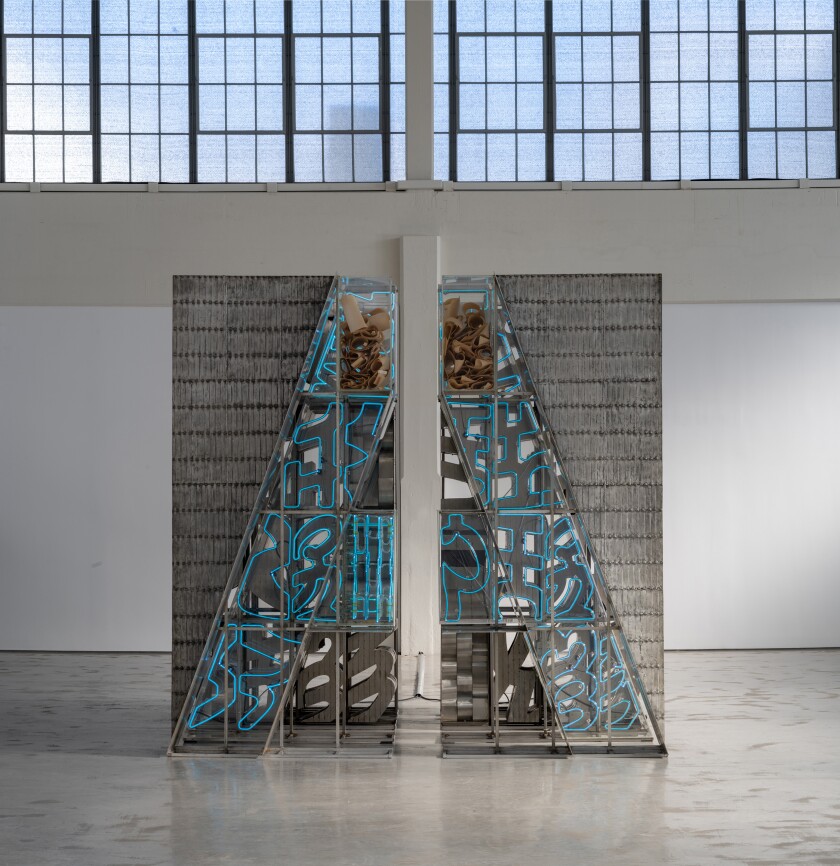It’s an all-too-familiar story in the arts world (and beyond): Woman becomes famous. Woman dies. Woman is all but forgotten.
That in a nutshell is the tale of Chryssa, who died in 2013. The Greek-born artist, who used just her first name professionally, was featured in the “Americans 1963″ exhibition at New York’s Museum of Modern Art alongside such heavy hitters as Lee Bontecou, Claes Oldenburg and James Rosenquist.
A touring exhibition that opens May 3 at Wrightwood 659, an alternative art space that opened in Lincoln Park in 2018, attempts to refocus attention on this unfairly neglected artist, and restore her to her rightful place in 20th-century American art history.
“Chryssa & New York,” the first museum show in North America in more than four decades to spotlight the artist, was co-organized by the Dia Art Foundation in New York and the Menil Collection in Houston in collaboration with Chicago’s Alphawood Foundation. It features more than 80 sculptures, wall reliefs, paintings and silkscreen prints, centering on the light art, especially her pioneering use of neon, for which she was best known, but also including work that touches on minimalism, conceptualism and pop art.
“One of the surprises of this show is the way she is known — to the extent that people know her now — for the work in neon in the ‘60s. But when you go the show, one of things that is really a surprise is the breadth of what she is doing in that time period,” said Megan Holly Witko, Dia’s external curator.
Chryssa Vardea-Mavromichali grew up in Nazi-occupied Greece and went to Paris to study art in 1953 but quickly shifted to the United States, opening a studio two years later in New York, which by then had supplanted the French capital as the center of the art world.
In short order, the young artist was included in the Whitney Annual in 1960 and featured a year later in solo shows at the influential Betty Parsons Gallery and Guggenheim Museum, and major collectors began to take notice.
The centerpiece of the Wrightwood exhibition is Chryssa’s most famous work, “The Gates to Times Square” (1964–66), a multilayered, 10-foot cube meant to suggest the celebrated New York landmark’s onslaught of intersecting lights and signs. The sculpture, which combines stainless steel, cast aluminum, Plexiglass and neon, was first shown at the Pace Gallery, another prominent commercial gallery in New York, and it was given in 1972 to a museum in Buffalo, N.Y., now known as the Buffalo AKG Art Museum.
“It’s really an incredible piece that was her magnum opus,” Witko said. “It’s a piece that was seen a lot at the time of its making. It was shown quite a few times in New York City and traveled to multiple other locations. It was her signature, her masterpiece.”
The rest of the show, which covers the 1960s and ‘70s when Chryssa was in her heyday in New York, looks at what led up to the piece and what comes out of it. Included are examples from “The Cycladic Books,” a series of proto-minimalist plaster reliefs with echoes of ancient Cycladic sculpture, and works like “Newspaper No. 3” (1961), a cast-aluminum relief based on type-blocks.
Although the exhibition is centered on New York, the Wrightwood installation also touches on Chryssa’s connections to Chicago, where she almost moved to in 1994, according to a letter that she wrote to the Art Institute of Chicago.
Her first connection to the city came in 1966 when “The Gates to Times Square” was shown at the 68th American Exhibition at the Art Institute, but more important was a 70-foot-tall light sculpture that she designed in 1980 for an office building at 33 W. Monroe St. It consisted of six stacked modules, each with what Chryssa described at the time as the shape of an arrow, the letter “M” or abstracted bird, and 900 feet of neon tubing. During remodeling of the building in the early 2000s, the piece was dismantled and discarded, but some archival images of the work will be shown.
According to Ashley Janke, an assistant curator at Wrightwood, that piece opened many doors for Chryssa, leading to the incorporation of works by her in the collections of the University of Chicago and the DePaul Art Museum.
There are multiple reasons for Chryssa’s fall into near obscurity, starting with the style with which she is most associated. “Light art as a movement fell out of interest, fell out of fashion, and with it, Chryssa fell off the radar,” Witko said.
At the same time, said Michelle White, senior curator at the Menil Collection, art historians are always looking for “neat categories.” “Chryssa doesn’t fit into these neat categories,” she said. “She has a foot in all of them and it makes it hard to fit her work into a neat story.”
And finally, it is impossible to ignore that simple reality that she was a woman in an art world dominated by men.
“I don’t want to rest it solely on that, because I think there were a lot of different factors, but, of course, that was absolutely a part of it.”
Catch up on all the top entertainment and cultural arts as well as movie and theater reviews and more by subscribing to our Entertaiment newsletter.










